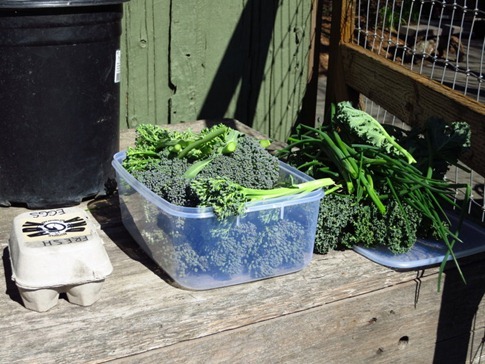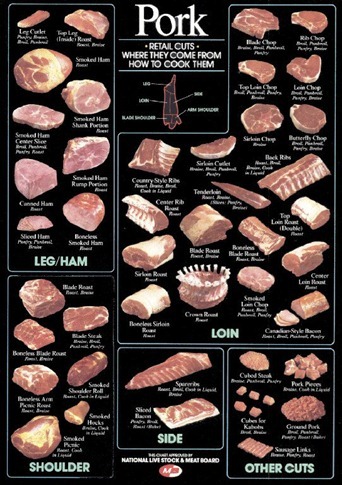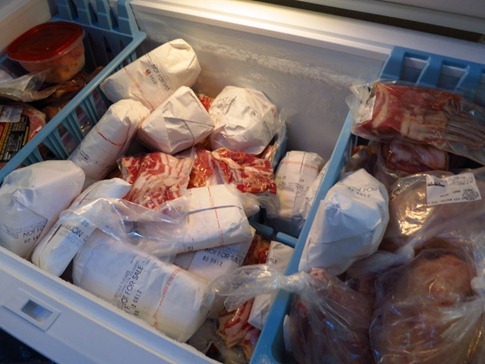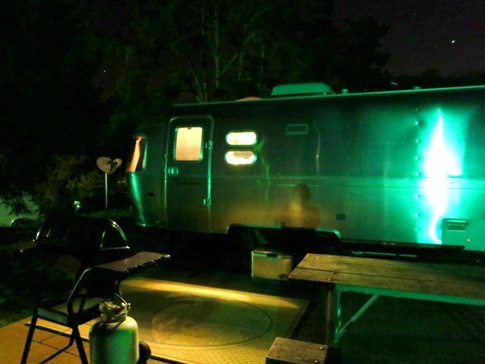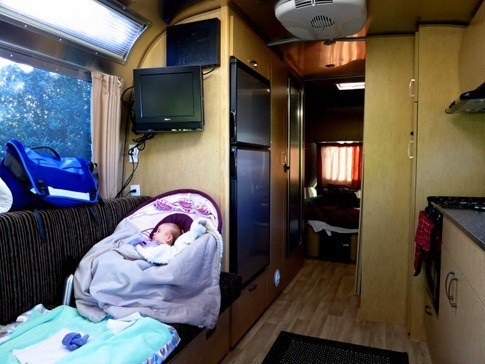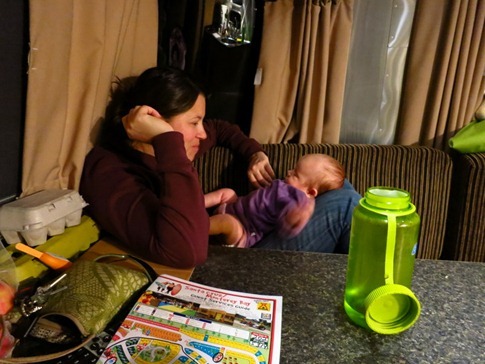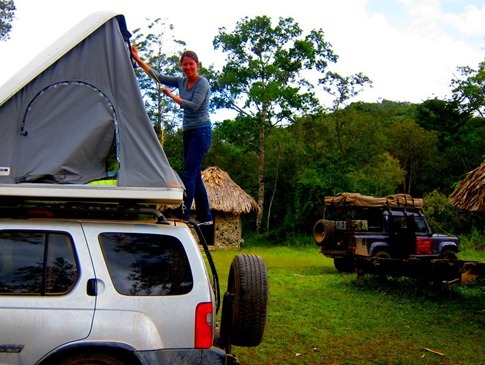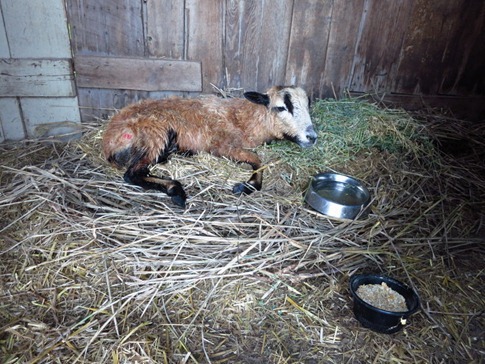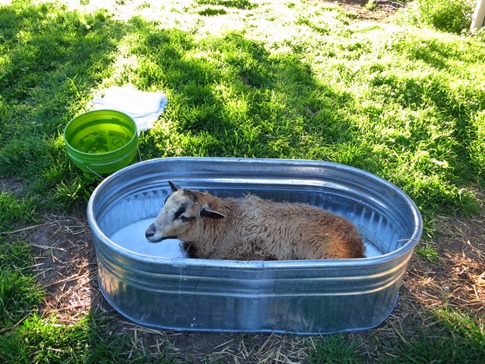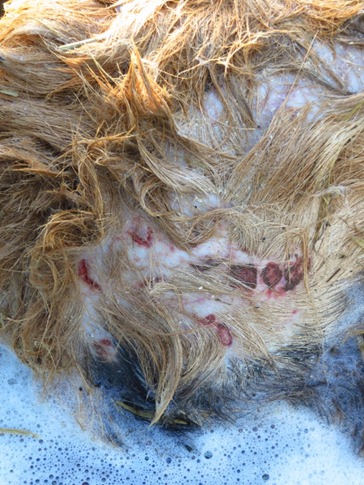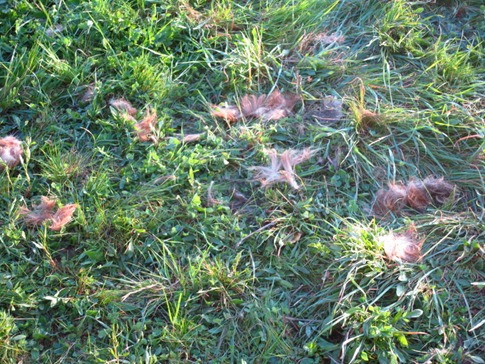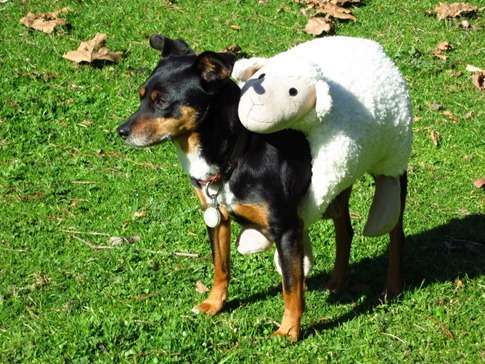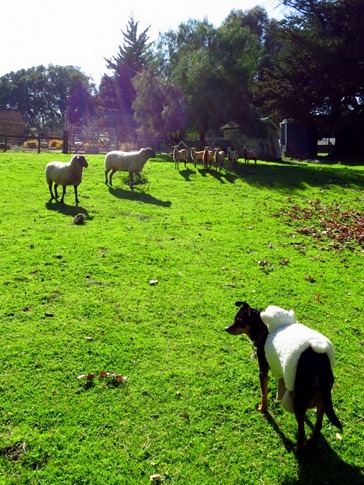Yes, I said “loin” because this month we had our two Berkshire hogs processed. Remember, “processing” is the euphemism we use for killing animals and having them packaged into the shapes and sizes we’re used to seeing the grocery store. So let me just warn you right now: THIS POST ACKNOWLEDGES THE SOURCE OF MEAT. IF YOURE MORE COMFORTABLE NOT THINKING ABOUT IT, CLICK HERE FOR SOMETHING ELSE. Or you can SKIP down to the part about the lamb (no, not eating them). I bet you’re wishing we’d just go back to baby pictures and talking about dirty diapers right about now…
Thus far, our experience in producing our own food had been growing a few vegetables in the garden and collecting eggs from our nine chickens. Oh, and carbonating our own water…
I had spent a morning at Tara Firma Farms where I got my first up-close-and-personal look at exactly what’s involved in putting meat on our table, and Ann and I had done a lot of thinking about exactly how much we could justify eating. We acknowledge that we’re omnivores and personally find that our bodies function best on a diet with at least some meat. We’ve been taking steps to make sure the meat we eat has been produced in the most natural, sustainable and humane way possible, first through a CSA meat box from Marin Sun Farms and then by finding two Berkshire piglets we could raise and have butchered for our freezer.
I’m not convinced that the technique to estimate the weight of a hog described in Storey's Guide to Raising Pigs isn’t just a way to make farm newbies chase their pigs around the paddock with a measuring tape looking ridiculous. Instead, I just kinda eye-balled it, comparing my 185 pound frame down on all fours with the more compact and muscular bodies of “The Bacon Brothers” to gauge how close to 200 they might be. Nothing ridiculous about that! Really, there just came a point when every week, the two of them seemed to be going through another three 50 pound bags of feed, and it seemed that the cost of feeding them wasn’t worth the small amount of extra weight they would put on. And while I’d given them a 40’ x 40’ paddock with fresh grass to root every month, the boys were just getting big and a little skiddish. They’d had a good life living as pigs on pasture and it was time for their “one bad day.”
We’d driven by Bud’s Custom Meats while exploring the area and read Yelp reviews of the exotic selection of cuts they offer. Turns out they were able to schedule a “ranch butcher” who could come out to our property and do the kill and rough cutting at $50 per animal. After feeling squeamish about killing four chickens at Tara Firma, I was happy to pay a professional to handle the pigs and wanted to make sure everything was done as quickly and efficiently as possible.
[ONE MORE WARNING… IT’S ABOUT TO GET REAL UP IN HERE. THERE NO PICTURES UNLESS YOU CLICK A LINK BUT READ ON AT YOUR OWN RISK]
The guy who came out was probly 25 or so and talked about having hunted all his life. He was happy to answer any questions I had about the process and check with me about 5 times to make sure I wanted him to "take" the pigs. He confirmed my feeling that the larger pig – there is always one “poor doer” who gets the second turn at the feeder – was about 200 pounds and the smaller more like 185. Instead of only processing the larger to let the other grow, I thought it was best for them to go together. After all, we’d gotten two of them mostly for the companionship. When I was ready, the butcher lowered a rifle to about 3 feet from the first pig, took careful aim through the sight, and fired at an imaginary “X” drawn from each eye to the opposite ear. He dropped right away and twitched a little, more as if from muscle reflex than from pain, before the butcher approached and made a deep incision below the jowels to cut the jugular and allow the blood to drain. The second pig startled at the shot, but after a quick sniff of the downed pig, soon shuffled off to check the feed bin, apparently unphased by the gun shot and more interested in the fact that he was now first in line for food. The butcher couldn't get the other pig quite so close so ended up taking a shot from about 10 feet. It squealed and stumbled a bit, but he quickly approached for a second closer shot which dropped him.
PIC: In the paddock with the pigs lining up the shot
It was over. We'd picked them up as 12 week old piglets weighing about 75 pounds each, and they'd lived on our land for about two months to grow to their current weight of about 200 pounds. We made sure they had clean water, ample food and fresh ground to nibble at and root up. We knew they'd had a decent life lounging in the sun under oak trees. It made us feel good that the butcher said ours was the "cleanest pig sty" he'd ever seen. But we'd raised them for meat, for meat that we'd know the source and composition of and that would mean a few less pigs raised in harsh environments and without respect for the sacrifice they would ultimately make. Too sappy? Well, you gotta tell yourself something to feel better about the two hogs bleeding out on your upper pasture. Honestly, it was hard to watch, but I felt I had to be present for the end and that in reality, feeling a little guilty about eating meat probably wasn't a bad thing. Or at least feeling appreciative.
The butcher proceeded to dismantle and skin the pigs, and it wasn't too long before they went from looking like wild animals to looking like sides of meat in a butcher shop. In fact, the last step was using an electric saw to cut each hog into two halves that could be hung by hooks in the back of his truck. Unfortunately, this was the exact time that the neighbors drove up our shared access road with their young kids in the back seat. I sent him an apologetic text, realizing that I should have had the butcher turn his truck to face inward. He responded that it wasn't a big deal; After all, we all chose to live in an agricultural, ranching area where people are more connected to the source of their food. I think it will be very interesting to see how the conversations about which animals are pets and which are dinner go with Wynne, and I’m sure you can count on hearing about our experiences here.
PIC: Meat cut into sides and hanging in the butcher’s truck
The butcher seemed happy with the amounts of meat and fat in the various parts, and I began to get really excited about seeing these all wrapped in white butcher paper in our freezer. A couple days later, I went through a cut list with the woman from the processor. To be honest, I was completely clueless as to which cuts came from which parts of the pig and which cuts precluded others (you can't have bone-in pork chops and ribs from the same side, for example). With two pigs, however, I was able to get a wide variety of cuts, selecting from the four sides. In the end, the hanging weight of the pigs was 175 and 135. We chose to have 116 pounds smoked as hams, bacon and sausage for a small additional cost.
Last week, we picked up 7 boxes of pork and filled every available crevice of our 14.8 cubic foot chest freezer and kitchen freezer. Since then, we've been enjoying AMAZING bacon, sausage, ham, and pork chops and haven't even started on ribs, loins, leg roasts, shoulders, etc. It feels great to have a supply of delicious, well-raised, healthy meat at the ready, and not have that feeling of dread - where was this raised, how was it treated, what did it eat? - when approaching the butcher counter at the grocery store.
I put together a little spreadsheet of the costs and yields. In the end, $3.50/pound is a pretty good deal…
| Growth | ||||
| Weaners | 2 | 150 | $ 300.00 | |
| Feed | ||||
| 11/30/2011 | RiverT | 1 | $ 15.68 | $ 15.68 |
| 12/5/2011 | RiverT | 2 | $ 15.68 | $ 31.36 |
| 12/15/2011 | H&B | 2 | $ 19.58 | $ 39.16 |
| 12/19/2011 | H&B | 2 | $ 19.58 | $ 39.16 |
| 1/1/2012 | H&B | 2 | $ 19.58 | $ 39.16 |
| 1/7/2012 | RiverT | 3 | $ 15.68 | $ 47.04 |
| 1/15/2012 | RiverT | 3 | $ 15.68 | $ 47.04 |
| 1/23/2012 | H&B | 3 | $ 19.58 | $ 58.74 |
| 1/31/2012 | RiverT | 1 | $ 15.68 | $ 15.68 |
| $ 333.02 | ||||
| Avg $/lb | ||||
| Feed lbs | 950 | $ 0.35 | ||
| Start weight | 150 | |||
| On the hoof lbs | 385 | |||
| Growth | 235 | |||
| Conversion % | 24.74% | |||
| Processing | ||||
| Processed lbs | 310 | $ 0.75 | $ 232.50 | |
| Addl smoking lbs | 116 | $ 0.85 | $ 98.60 | |
| Bacon slicing | 4 | $ 3.00 | $ 12.00 | |
| "Harvest" | 2 | $ 50.00 | $ 100.00 | |
| $ 443.10 | ||||
| Total Cost | $ 1,076.12 | |||
| Price per pound | $ 3.47 |
Moving on… I wrote that March came in like a loin (to the freezer) and out like a lamb. But before I tell the second half of the story, I need to mention that Ann and I have been doing a little shopping lately for an Airstream trailer. While we came back in off the road to settle down a bit and have a baby, we’ve always planned to continue traveling (even more on this next month). We fell short of our potential goal of driving south to Tierra del Fuego and only made it Panama, but our thought is that the leg of the Panamerican Highway north between San Francisco and Alaska might be our next adventure and easily doable with a baby. And what better vehicle to travel the US (and a bit of Canada…) in than an Airstream?
I’ve said it in this blog before, but Ann and I tend to get a little obsessed with “the idea” of certain things and find that the best way to process the obsession is by getting our toes wet; Half the time we think, “Whoa, what were we thinking?” and the other half “Here we go!” (see: Baja Shakedown) Well, I found a campground down near Santa Cruz that rents Airstreams by the night. Even better, it was located an hour and a half from the closest Airstream dealer. The plan was to head down to spend a night in a silver tube, check out the models on the dealer lot the next day, and return to the campground to process it all. Plus, this would be our first road trip of any substantial size with a baby.
I can’t tell you how many times in the last weeks I’ve entered the search phrase “Airstream trailer worth the money?” Of course, some of what you’re paying for is the iconic look, but we were genuinely impressed by the quality of the cabinetry, thoughtfulness of the design, and solid feel of the 25’ unit we stayed in. Sure, everything’s a little more cramped, but we honestly felt like we were staying in a hotel.
We made dinner outside on the BBQ – pork chops (what else?) and broccoli from our garden and settled in to watch some TV on the swivel out flat panel LCD TV while reminiscing about watching episodes Mad Men in the back seats of the Xterra or up in the roof top tent.
The text came at about 9:15 in the morning, just as Ann was emerging from a hot (if “cozy”) shower in the Airstream bathroom. It was from the neighbor up the hill from our house and simply read “Are you home?” It could have been anything from wanting to come down and see the baby or let his kids play in the tree house, but I had a bad feeling about it. We’d just spent two long weekends up in Lake Tahoe and then driven down to Santa Cruz with only a day at home between. My guilty conscience about leaving the animals was further antagonized by one bar of cell signal which only allowed me to hear something about “sheep,” “fence” and “pretty bad” on the voicemail he’d left earlier in the morning. I contorted myself in a show of subservience to the AT&T gods and managed to send and receive enough texts to understand that one of our Blackbelly sheep was on his side of the fence and looked like it had been attacked by something. It was alive but couldn’t move. After a hasty evaluation, we threw everything back into the car and headed north towards home.
There wasn’t much we could do on the 4 hour drive home but think about the possibilities. Earlier in the month, we’d had two animals butchered to stock our freezer. We’d bought the Blackbelly sheep both as weed eaters and as a meat source. If this sheep wasn’t doing so well, would we pay the 25 year old with the rifle and bone saw $50 to butcher it or a vet $500 to heal it?
When we arrived, we found the sheep in the small animal barn where the neighbor had been nice enough to leave it with some fresh water and alfalfa. While we’d generally not felt the need to name our animals (possibly because there was a chance they might some day become dinner) we’d always called this one “Mama,” thinking her mellow demeanor – she was the first of the Blackbellies to approach us to eat out of our hands – would make her a great mother when we wanted to grow our little herd. Of course, that trusting instinct might have been exactly what got her into trouble with whatever it was that got her. I remember the shearer we hired for the Suffolk sheep last year had commented that sheep were actually bred to lie down and be submissive for shearing, something coyotes often took advantage of.
I picked up the little sheep, the first time I had really touched her, and brought her outside to a galvanized trough filled with warm water and some of Gorilla’s dog shampoo. As the water immediately turned a rich chocolate brown from the dirt (and a little poo) that coats a sheep’s hair and conditions their skin, I felt around to to the back of each haunch where chunks of hair were missing. As she trembled stoically under this further trauma, I found what looked like several puncture wounds on each side along with some abrasions that could have been from her struggle to get over the barbed wire fence. I cleaned everything out as best I could and dried her off with an old towel before wiping some antiseptic Betadine solution onto the areas. We went with the Betadine after noticing that the label of the other stuff we’d picked up on the way into town listed it as a harsh carcinogen and not suitable for use on animals meant for human consumption. At this point, we really weren’t sure whether Mama would pull through.
I left her in the sun with some water, alfalfa and the grain she used to love eating out of our hands and walked up to the back fence to check out the crime seen. The neighbor had found her because his two yellow labs were down by our fence – actually 15 feet from it because of their electronic fence collars – taking turns lying next to the injured sheep while the other ran back and forth to the house barking. While this behavior could also have been interpreted as “protecting their kill,” I don’t see any way they could have crossed their electric fence, jumped our barbed wire fence, chased the sheep back over the fence and reversed the process. At this point, our best guess is that a coyote got into our pasture, sent our herd into a panic, singled Mama out and chased her until she made a heroic leap over the back fence. When the neighbor dogs came down to check out the commotion, they must have scared the coyote away and saved Mama.
Over the next week, I carried Mama from the small barn out into the sun every morning and put her back inside at night, until one evening I couldn’t find her anywhere. I counted the rest of the sheep in the pasture, 2 Suffolks and the 5 healthy Blackbellies, but no Mama. I finally poked my head into the barn, and there she was! She’d somehow managed to hop back to where she knew she’d be safe for the night. The next morning, she was out in the sun before I got outside. From the kitchen window, I caught glimpses of her throughout the day hopping on her two left legs and then collapsing in a fresh patch of grass for a rest and a snack. About a week and a half after the neighbor found her unable to walk, I took this video.
The incident has left us a little spooked. We’d heard rumors that the previous owner had had seven or eight Suffolk sheep before something started killing them off one by one, leaving only the two we have now. But there are so many sheep in the area, most in wide open fields away from houses and barking dogs, you’d think there would be easier prey. Our fence is anything but predator proof and trying to make it otherwise would be futile. For now, we’re locking the sheep in the lower pasture at night and looking into some options for livestock guardian animals. While many people swear by the instinct of a llama or an alpaca to guard a flock, for now we’re looking into some “in house” solutions…


